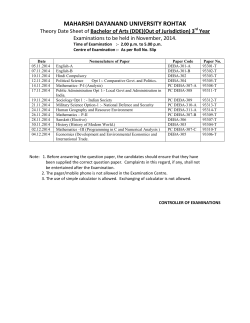
Syllabus
BUSSTAT 208 Three-Week Summer Session 2015 Instructor: Phil Fry Office: 3237 MBEB Office Phone: 426-4276 Office Hours: 10:30 – 11:30 Mon-Fri; 2:15 – 3:00 Mon-Thurs. E-mail: pfry@boisestate.edu Textbook: Business Statistics: A Decision Making Approach, 9th ed. Groebner, Shannon, Fry, and Smith. Pearson Publishing. Course Overview: Business Statistics 208 is the second course in a two-semester introductory statistics sequence. The objectives of this course are to make the student aware of the presence of uncertainty in business decision-making and to emphasize the role of data analysis on reducing that uncertainty. This class provides a survey of a variety of techniques that extend the methods introduced in Business Statistics 207. This class will emphasize identification of applications, the assumptions underlying each technique, appropriate analysis of the data, interpretation of the findings, and communication of the inferences made. The key is in understanding the logic and procedures, not in memorizing the formulas. Prerequisites: BUSSTAT 207, MATH 160, ITM104 and ITM105 or successful completion of the qualifying exam. Each student is responsible for demonstrating a C- or above grade in all prerequisite classes. Learning Objectives: Upon completion of this course with a grade of C or better a student should be able to: • • • • • • • • Estimate and Test Hypotheses for Two Population Parameters Recognize ANOVA applications and analyze data using one and two-factor ANOVA procedures Formulate, analyze, and interpret simple and multiple regression models including the use of dummy variables Recognize non-parametric statistical applications, compare parametric and non-parametric procedures, and apply selected non-parametric procedures Identify and distinguish among components in time series data Develop, evaluate, and apply basic forecasting models Apply chi-square procedures to compare multiple population proportions, check for independence, or examine goodness of fit Use Excel software as a tool to store, organize, and analyze data using the statistical techniques introduced in this course Three-Week Summer Session Course Outline (Instructor reserves the right to make changes). Date Monday- May 11, 2015 Tuesday- May 12, 2015 Wednesday-May 13,2015 Thursday-May 14,2015 Friday-May 15,2015 Monday-May18,2015 Tuesday-May 19,2015 Wednesday-May 20,2015 Thursday-May 21,2015 Friday-May 22,2015 Monday-May 25,2015 Tuesday-May 26,2015 Wednesday-May 27, 2015 Thursday-May 28, 2015 Grading Friday-May 29,2015 Topic Chapter Estimation & Chapters 8 & 9 Hypothesis Testing Review Estimation & Chapter 10 Hypothesis Tests for Two Population Parameters. Estimation & Chapter 11 Hypothesis Tests for Two Population Variances. Analysis of Variance Chapter 12 Analysis of Variance & Chapter 12 Review Examination I Chapters 8-12 Introduction to Linear Chapter 14 Regression & Correlation Analysis Introduction to Linear Chapter 14 Regression & Correlation Analysis Multiple Regression Chapter 15 Analysis & Model Building Multiple Regression Chapter 15 Analysis & Model Building MEMORIAL DAY HOLIDAY Multiple Regression Chapter 15 Analysis & Model Building Forecasting Time Series Chapter 16 Data Forecasting Time Series Chapters 16 & 13 Data & Goodness of Fit Tests Final Examination Comprehensive Examination I Final Examination Quizzes/Problem Sets Total 75 Points 125 Points 100 Points 300 Points Quizzes and Problem Sets will be announced in class and on Blackboard. Students should check Blackboard twice a day, every day during the summer session. Grading Scale: Final Score 277 267 - 276 260-266 246-259 236-245 228-235 208-227 201-207 178-200 < 178 Final Grade A AB+ B BC+ C CD F
© Copyright 2025





















![COO3A1 Econometrics for Finance [4 Credits] Learning Objective](http://cdn1.abcdocz.com/store/data/001102196_1-a1bfcbf696b2dde07865cdb8e2e08339-250x500.png)